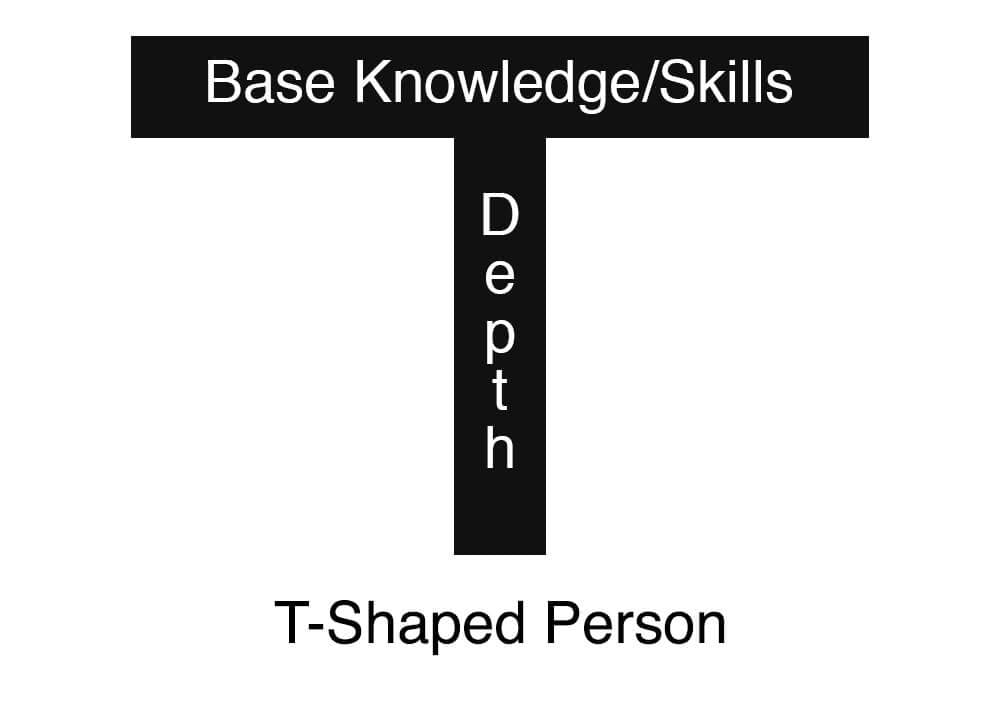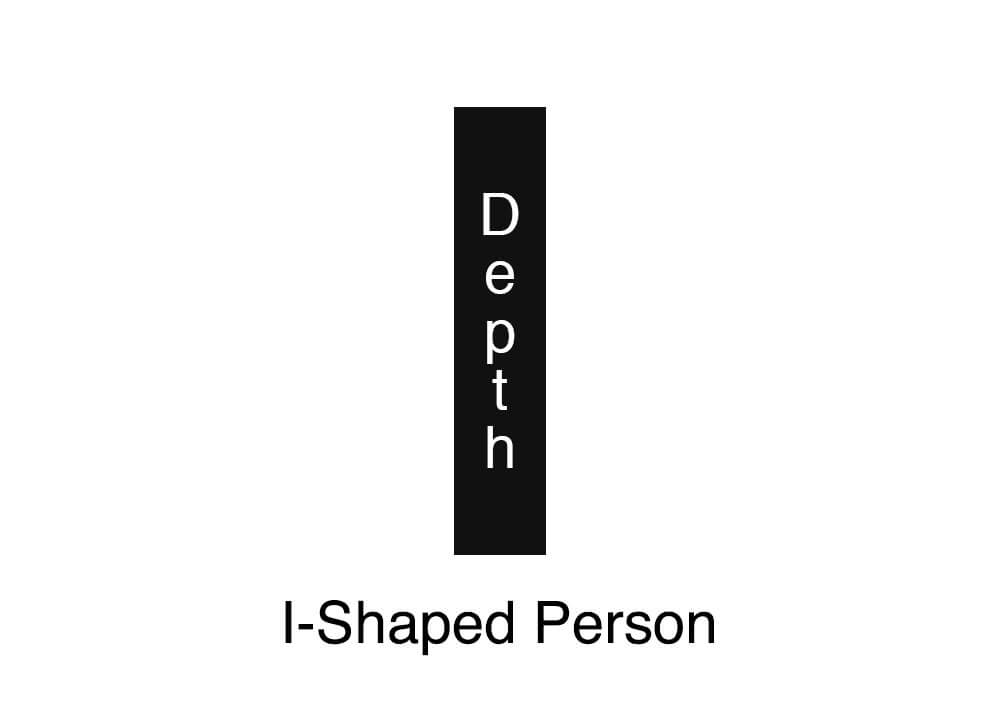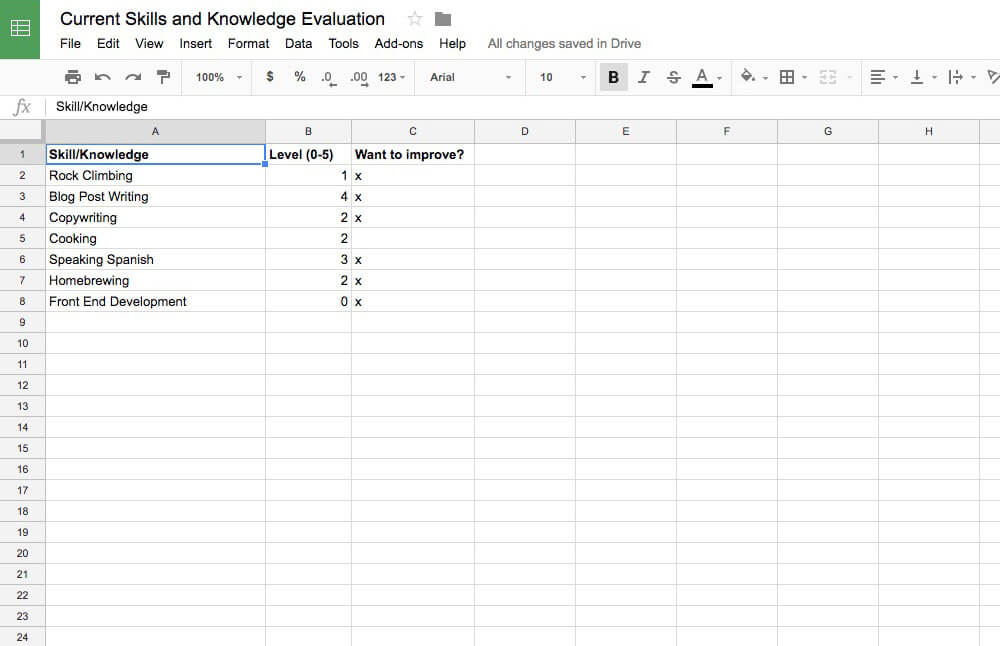I dunno about you, but I’ve never been content just having one interest. I’ve always dabbled in lots of things. Over the years, these things have ranged from swimming to drawing to 3D modeling to rock climbing to essay writing to online business (to name just a few). Throughout all of that, however, writing remained my focus, the thing that I would tell people I was “good at.”
What’s more, I realized that the people I admire were also, generally, into lots of different things, even while specializing in a particular area. Take Henry David Thoreau, for example. People remember him for his writings on nature (Walden) and politics (Civil Disobedience), but the dude was into history, biology, poetry, botany, travel, land surveying, and more.
It wasn’t until recently, however, that I learned there was a name for this phenomenon. I first came across it in an article on the Buffer blog, and I’ve since seen it all across the internet (an example of the priming effect in action). What is this magical term? It’s called the T-shaped person, and I think it’s one of the most powerful concepts for anyone who wants to build a diverse skill set while still having a valuable specialization.
In today’s article, I’m going to explain what a T-shaped person is, why it can benefit you, and how to begin your own T-shaped journey.
So if you’re ready to “stretch yourself”, then let’s get started!
What is a T-Shaped Person?
No, being a T-shaped person has nothing to do with badass robot body parts à la Terminator (at least not in this context). Here’s what it means to be a T-shaped person:
A T-shaped person has deep knowledge/skills in one area and a broad base of general supporting knowledge/skills.
If you represent this depth and breadth visually, you get a “T” shape:

The exact details will vary from person to person. Indeed, if you’re just starting out, you may find that your knowledge/skillset looks more like an “i” (a specialist with no general knowledge):

Or maybe a “dash” with diverse general knowledge but no specialization:

If either of the above is the case, no worries. I’ll show you how to start building your “T” in a moment. First, however, let’s explore the benefits of being a T-shaped person, both in college and beyond
Benefits of Becoming T-Shaped
I like to think of the T-shaped person as an improvement on the classic saying “Jack of all trades, master of none.” A T-shaped person is a “Jack of many trades, master of (at least) one.”
When you commit to being T-shaped, you get the benefits of specialization and generalization, while avoiding the pitfalls of being only a specialist or generalist. Here are just a few benefits:
You’re better at collaborating with others.
Because you have a broad range of knowledge, you know just enough to communicate with specialists in different fields. This makes collaboration much easier. For example, if you’re a history major (i.e., a history specialist) with a basic understanding of data visualization, you’re going to be able to work much more effectively with the computer science student helping you model a historical trend for your final project.
You stay interested.
When you focus on just one area, it can get monotonous. No matter how fascinating the topic, variety is key to keeping your mind engaged. As a T-shaped person, you always have other areas to dip into when you need a break from your specialty.
You experience the satisfaction of depth.
Even as you get to move around to different areas to avoid getting bored, you also get to experience the satisfaction that comes from diving deep into one subject area. The deeper you go, the more you realize how vast your area of knowledge is and how there’s a lifetime of learning ahead. I find this super exciting, more thrilling than any video game or Netflix series. If you’ve never experienced this, you need to give it a try.
You become more creative.
There’s a classic idea in the arts (and in business) that the greatest ideas happen at the intersection of disciplines. When you have a broad base of knowledge, you build immunity to the “paradox of expertise” where your advanced knowledge of one field clouds your ability to see new ideas. For example, Vihart’s YouTube channel shows you what happens at the meeting of math, music, and visual art.
You’re more attractive to employers.
This happens for two reasons. The first is that you’re going to have a standout resume compared to someone who only focused on their major and never branched out. Consequently, you’ll be able to bring more to a job than someone who only meets the requirements the position specifies.
Second, being a T-shaped person just makes you more interesting. This benefits you from the moment the hiring manager sees your resume to the moment you interview. I mean, come on, who doesn’t want to talk to interesting people? (Especially if the other job candidates regurgitate the same boring formulas in their applications).
Now that you’re excited about all the benefits of becoming a T-shaped person, let’s move on to how to do it!
How to Become a T-Shaped Person

Becoming a T-shaped person is like the ultimate choose your own adventure game. Except the rules aren’t as clear and the set of possible adventures is nearly infinite. Pretty exciting, right?
The first question to address when starting on your T-shaped journey is What skills should I build? What should I learn?
Unfortunately, there isn’t one concrete answer. It all depends on the goals and values you’ve defined. I can give you a general framework, however.
First, you need to assess what skills and knowledge you already have. In addition, you need to rate your ability in each area. You can do this however you like, but I’d suggest that you make a spreadsheet where you write down all the skills and knowledge you can think of, and then rate each on a scale of 0-5. Here’s how I think of each level:
- 0 – You know (almost) nothing besides the name of the area. You want to learn it but haven’t practiced or studied it.
- 1 – You’re a novice. You’ve started learning, but you don’t know how to do anything yet. If you want to put it in college terms, you’re in the first few weeks of a 101 course.
- 2 – You’re an advanced beginner. You can do a few things on your own, but you still need lots of guidance and formulas
- 3 – You’re now competent. You’ve gotten past the introductory material, and you’re figuring out where to apply the different rules you’ve learned.
- 4 – You’re proficient. You can do things that most people can’t even think of doing. You’re not perfect, and you still have to think about what to do in certain situations. But you’re really good.
- 5 – You’re an expert. You operate using intuition above all else, and to an outside observer, your performance looks like magic.
Here’s an example assessment I created based on my current skills and knowledge.

To do your own self-assessment, download the spreadsheet here (to edit it, go to File > Make a copy…).
Once you’ve done this honest self-assessment, you need to determine :
- Where you want to improve your knowledge/ability.
- Where you comfortable maintaining.
- What you want to add.
- Where you want to go deep.
Let’s break each of these down:
1. Improvement
When you rated yourself for each of your existing areas, you probably noticed some that you wish were stronger. For example, I’d like to improve my copywriting and rock climbing skills. Make note of these areas in the spreadsheet so that you can start working on them.
2. Maintenance
In some areas, you’re perfectly content with your level and have no interest in going further. This is fine. Don’t waste your time improving areas that don’t matter to you.
For example, I’m fine with my very basic cooking abilities. I know enough to healthy cook with sufficient variety, and I’m not interested in becoming the next Binging with Babish. As long as I cook regularly, I’ll maintain my skills no problem.
3. Addition
These are things you currently know nothing about but want to learn. They’re the areas that you marked “0” next to in your self-assessment spreadsheet. Maybe you need to learn them to make yourself a better job candidate, or maybe they just interest you. Whatever the reason, you want to start learning. For example, I want to learn web development so that I can build cool projects to supplement my writing.
4. Depth
Finally, you need to identify the area where you want to specialize. This is the “stem” of your “T”. You may already know what this area is (for me, it’s content writing/storytelling). It could be an existing area; for example, what you’re studying in your major. Or it could be something you know nothing about but really feel will be useful/interesting. Regardless, you need to identify this area so that you can focus on it.
I would also add these suggestions when picking what to learn:
Mix hard and soft skills.
If you’re not familiar with the difference between hard and soft skills, have a look at this article for a full introduction. Basically, hard skills are technical abilities that you can easily quantify (blog post writing, programming, design, DDR). Soft skills, on the other hand, are things like critical thinking, self-confidence, and networking. You should make sure that your “T” has a good mix of both. Personally, I’m inclined to skew very hard toward only hard skills, so I have to make a concerted effort to build in some soft skill foundation as well.
Focus on what interests you.
There are lots of skills people will you tell you that you should have. Heck, I’m guilty of it in my writing. While I (and Thomas) maintain that there are areas that everyone would benefit from knowing about, you should focus first and foremost on what interests you. Particularly for the area you choose to go deep, don’t pick something just because it’s “marketable” or because it sounds impressive at parties. Pick something that really fascinates you, because that’s what will get you through the sucky times where making progress is hard and you want to quit.
If unsure, dabble.
If you have no idea what you want to go deep on, then learn the basics of a few things that sound interesting. You’ll quickly figure out which is worth putting more time into. This is similar to the classic advice for freshmen unsure of what to major in: take a variety of classes to figure out what you like.
Don’t let your major limit you.
Just because you’re studying chemistry, that doesn’t mean you have to become a chemistry specialist. You may enjoy the general knowledge and thinking patterns that chemistry teaches you, but know that you don’t want to do it for a career. You might find design more exciting, for example. If that’s the case, then learn about design on the side! Your major does not define you!
Strike a balance of general/useful.
You want to make sure that your base areas are specific enough to be useful (without being too specific). For example, “computer skills” is too broad to form the base of your “T”. What kind of computer skills? Photoshop? Data analysis? Web design? TPS report creation? You’ll learn to find this balance with time.
Read across a variety of subjects.
One base area that I think everyone should have is that of being “well-read”. This builds the habit of intellectual curiosity and challenging your ideas. Read whatever interests you, but read across a range of areas.
Now that we have those ideas out there, let’s get into the practical specifics. What does becoming a T-shaped person look like on a daily basis? I’ve found that the following are key to success:
1. Make it a habit.
We talk about habits a lot here at CIG. But that’s because they make up such a huge portion of your life (40% of your daily actions, according to Duke University researchers). So when you take control of your habits, you gain immense power.
You need to make developing your T-shaped self a habit. I do this by taking each area that I want to improve/maintain and adding it to my daily to-do list. I make sure to check it off each day, and I use Beeminder to make sure I do the ones that I would otherwise slack on (currently these are learning Javascript and practicing Spanish).
For an introduction to Beeminder, have a look at how Thomas uses it to wake up early and have a listen to his interview with its founders.
2. Work on projects.
You may have noticed that I don’t have to use Beeminder to get me to practice writing. This is because I practice writing every day as part of my job. You can get the same benefits through freelance work or just creating something in your spare time. For example, if you want to learn WordPress, you can create a personal website.
3. Regularly evaluate your progress. Making your practice a habit is the first step, but if you want to improve you need to evaluate your progress regularly. Here are a few self-evaluation ideas:
- If you want to test a particular knowledge area, read a recent paper from the field and rate your understanding of it from 1-5.
- Use the Feynman Technique: Take a piece of paper and write everything you know about the topic. You’ll quickly find the gaps in your knowledge.
- Teach your skill to someone else. Similar to the Feynman technique (but with more immediate feedback), this will expose areas that you don’t really understand.
- If you’re learning a language, record yourself talking about a random topic for 5 minutes (thanks to Martin for this tip).
Just make sure you test yourself periodically and tailor your practice accordingly, otherwise you’ll just be spinning your wheels.
4. Give your specialty extra attention.
For the area in which you want to become an expert, you need to pay special attention to your progress. Read up on the Dreyfus Model and see where you fall on the scale from Novice to Expert. Also, seek out a mentor who can help you once you’ve progressed past introductory learning materials.
5. Deconstruct skills.
Something like “learn rock climbing” is a huge, vague goal. So huge that it can feel impossible; so vague that it will be impossible if you don’t make it more concrete. To overcome the overwhelm, break the skill down. For example, you might decide to focus on just foot positioning or on strengthening your fingers. For more on this, have a look at Thomas’s guide to learning outside of class.
If you follow the above, you’ll be well on your way to becoming a T-shaped person.
Important note: Don’t let this framework limit you. While becoming a T-shaped person will put you miles ahead of most students, you don’t have to stop at going deep on just one skill. Become a polymath, by all means. Just make sure you avoid the generalist trap and really go deep on an area before you decide to pursue equivalent depth in another.
Conclusion

Building a T-shaped set of knowledge and skills is one of the most valuable things you can do for your future career and personal development. The combination of improved job prospects and never-ending intellectual engagement is something that most people will only dream of, but you’ll be able to make it a reality through your habits and commitment to the process. I wish you success in your journey.
And remember, this journey will be challenging at times. Don’t give up! The rewards are worth the struggle.
Image Credits: featured, multiple paths, field notes


